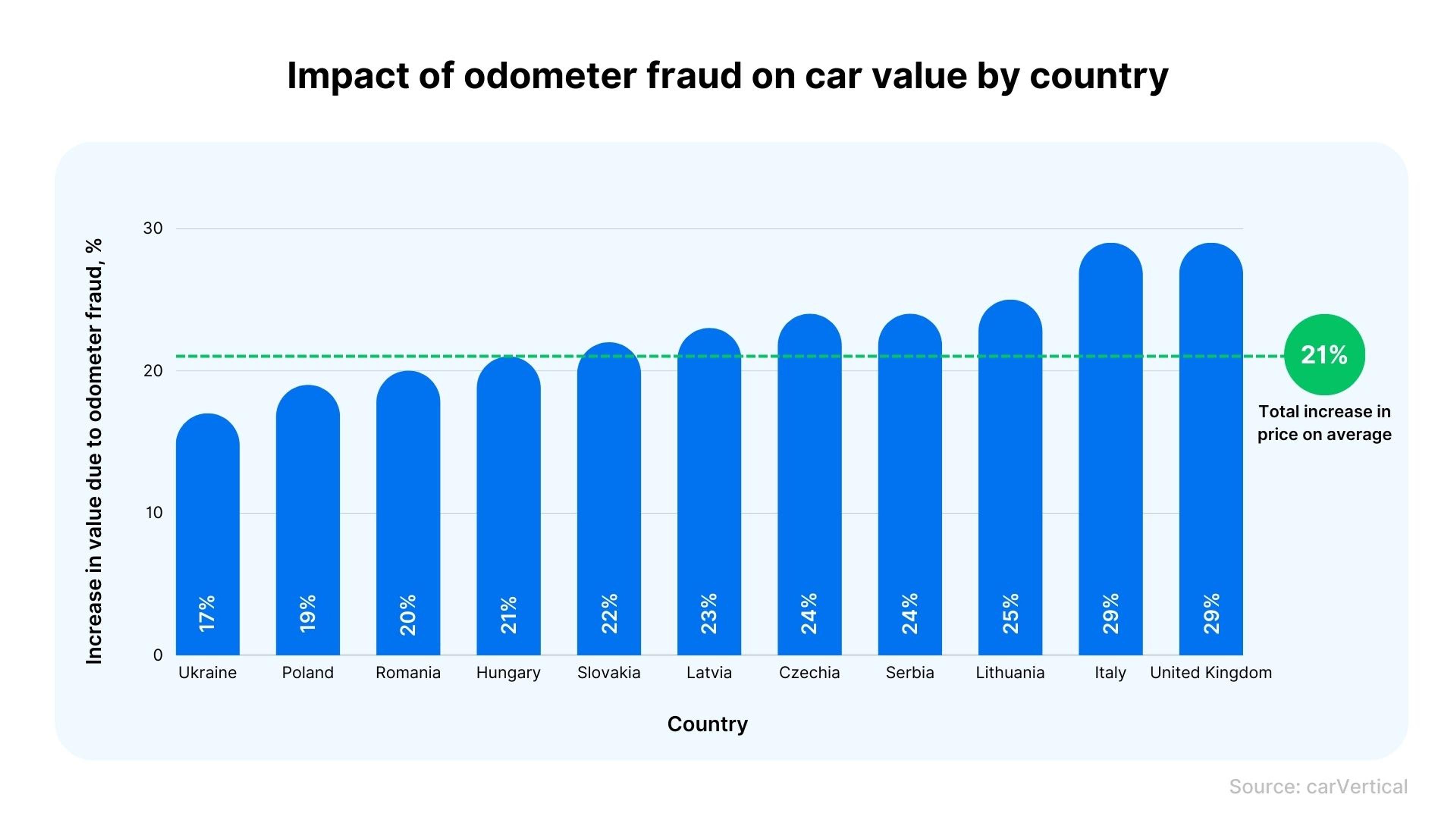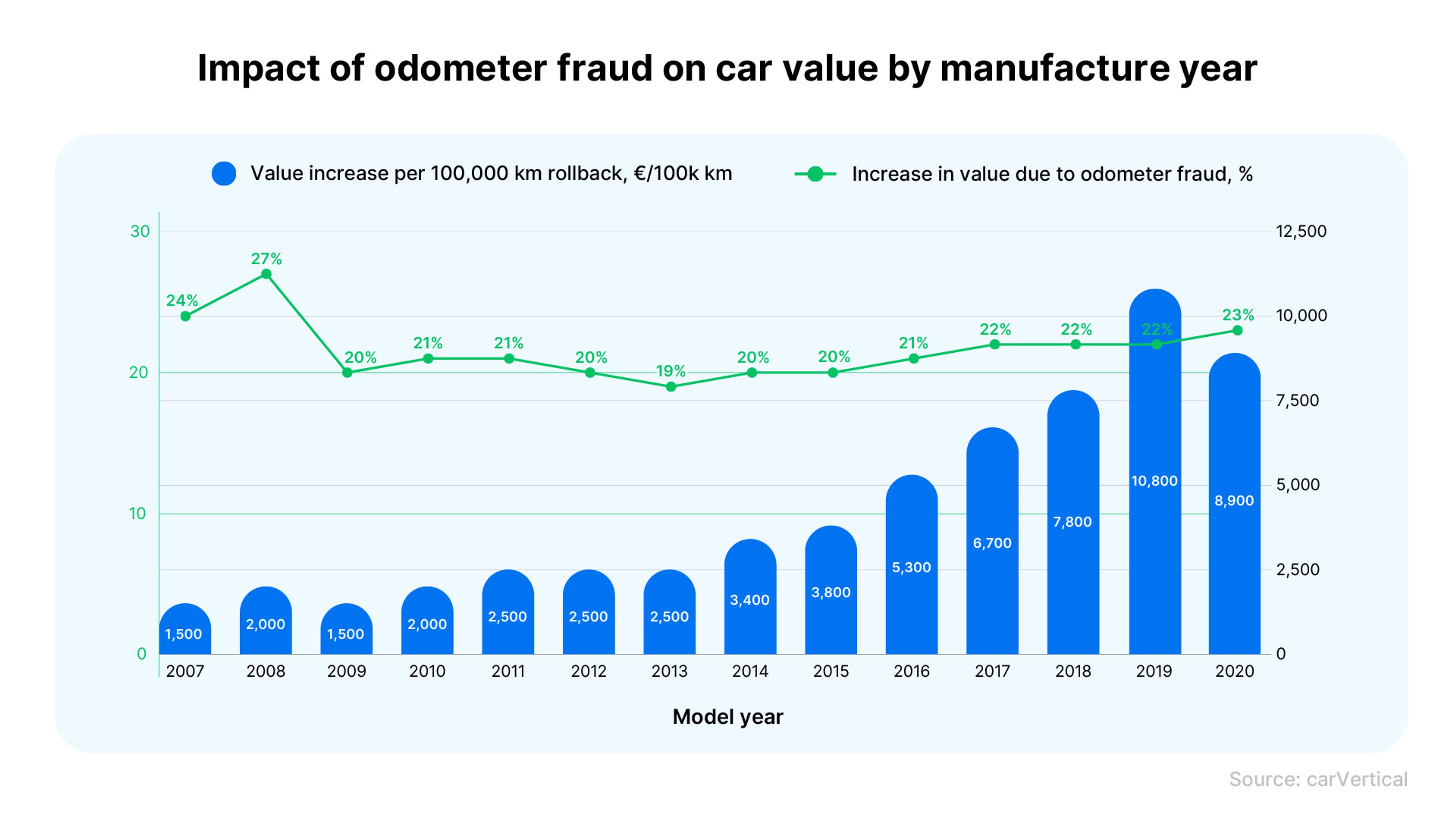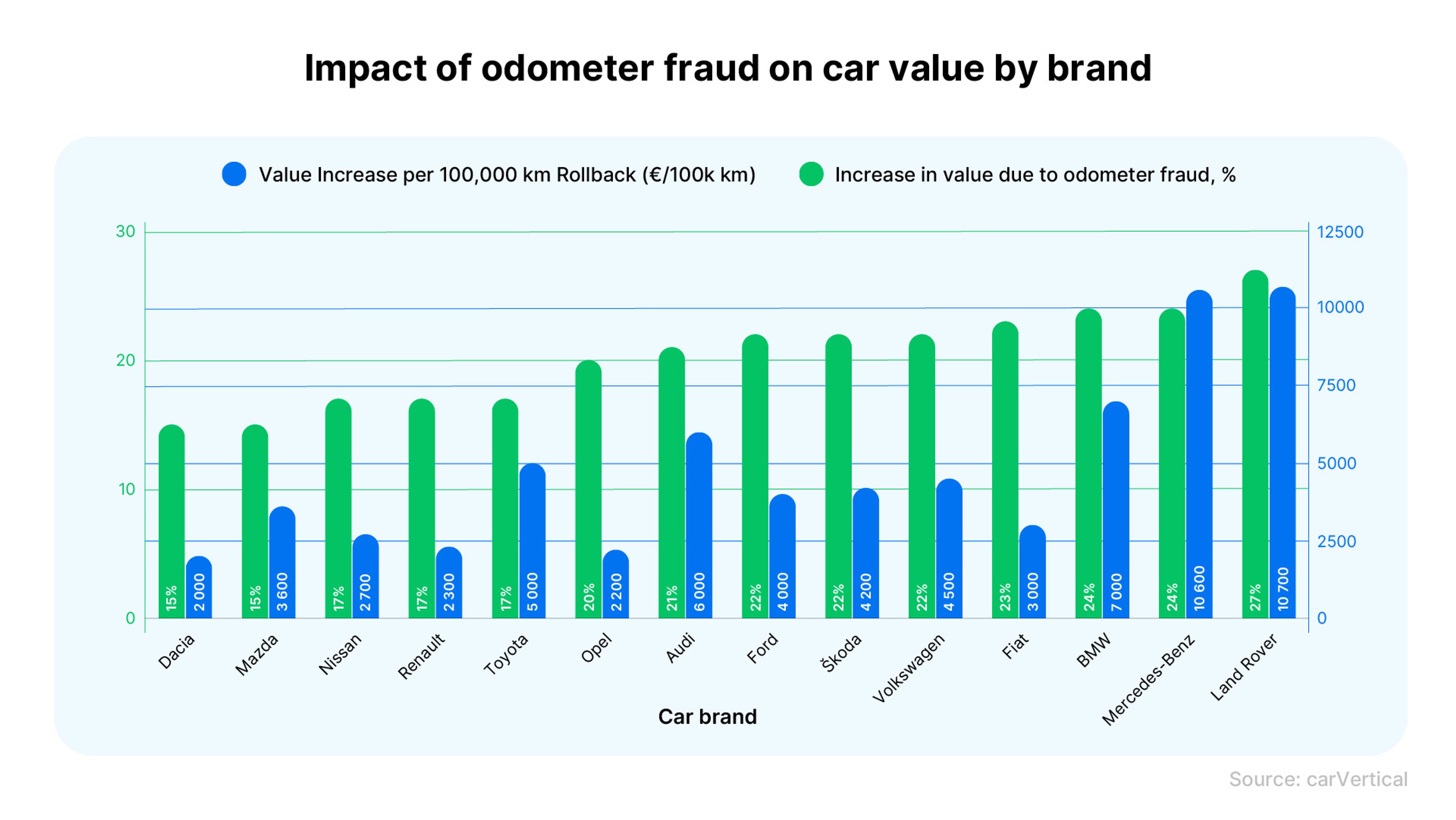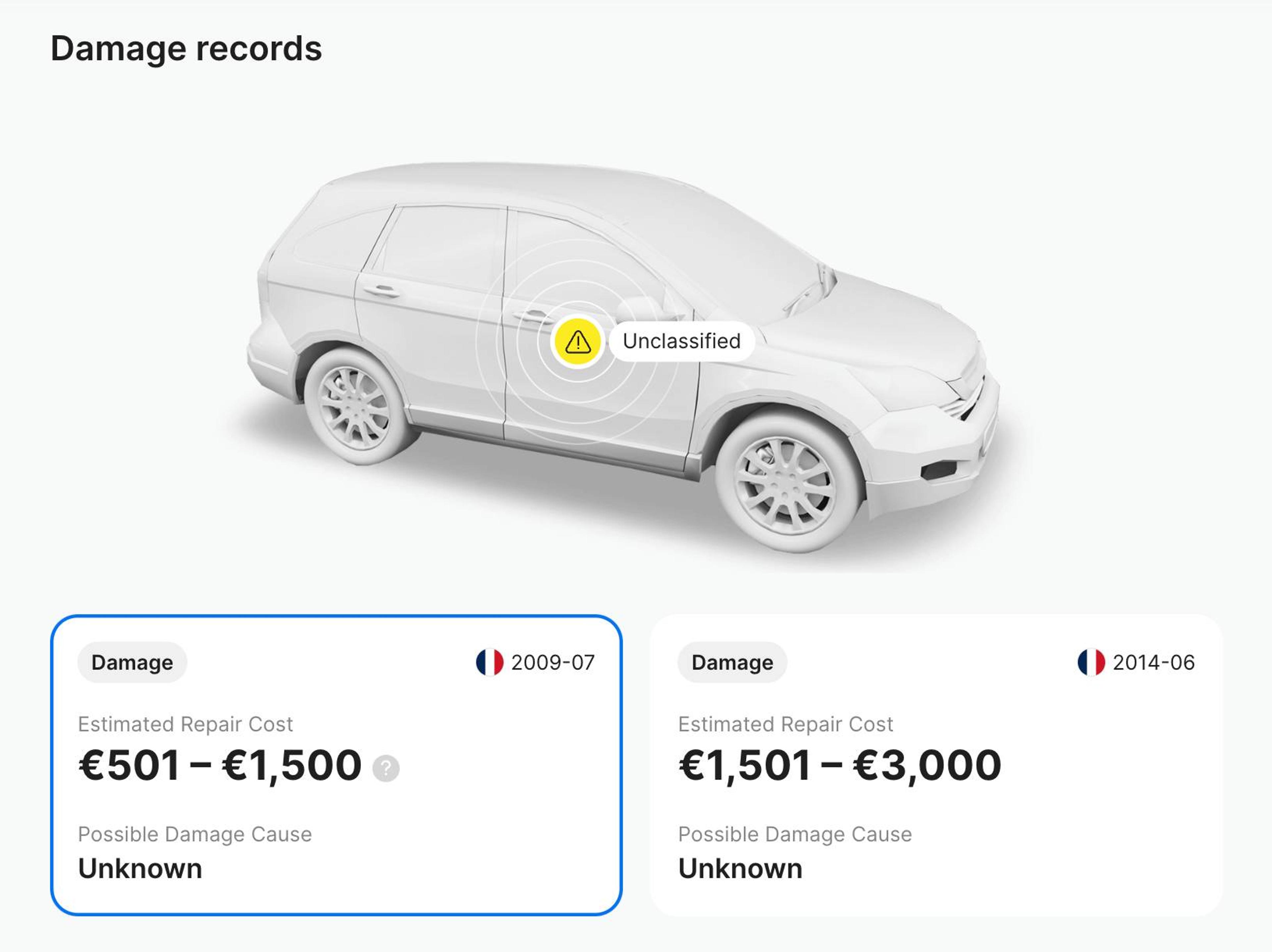19/10/2023
Research: How does odometer fraud inflate the value of a used car?

Odometer fraud is an alarming trend in the used car market, and it's especially common among older vehicles. With every kilometer clocked by a dishonest mechanic, the value of a car surges, leaving buyers with a deceptive sense of its true worth.
To better understand the connection between clocking and vehicle prices, we analyzed millions of carVertical history reports in 11 European countries – Ukraine, Poland, Romania, Hungary, Slovakia, Latvia, Czechia, Serbia, Lithuania, Italy, and the United Kingdom.

Afraid of buying a wreck?
Check any VIN to learn a vehicle's history!
Research findings
The analysis has unveiled that odometer fraud significantly inflates the price of a used car, leading to many used car buyers overpaying for a vehicle without even knowing it:
- Clocked car buyers spend 21% more on average for their vehicles.
- The price increase depends on many factors, such as the brand, year of manufacture, and the number of clocked kilometers.
- The United Kingdom (29%), Italy (29%), and Lithuania (25%) are among the countries where the value increase of clocked cars is the highest, while Ukraine (17%), Poland (19%), and Romania (20%) have the lowest impact of odometer fraud on a car’s value.
- For every 100,000 kilometers clocked, buyers overspend by approx. 2,000 euros.
- Car brands react to clocking differently, with price increases varying from 15 to 27 percent, resulting in overspending between 2,000 and 10,700 euros.
- The highest fake increase in value is found among Land Rover (27%), Mercedes-Benz (24%), and BMW (24%) vehicles, while Dacia (15%), Mazda (15%), and Nissan (17%) models are impacted by odometer fraud the least.
Clocked car prices vary across Europe, with the UK experiencing the highest artificial surge in value
According to data, buyers spend 21% more on cars with tampered odometers. While a 21% increase in value already seems like significant overspending, results vary across different countries, rising above the average in some of them.

Among selected countries, the United Kingdom (29%), Italy (29%), and Lithuania (25%) have the highest fraudulent increase in the value of a used car. It means that in some cases, buyers pay over a quarter more than the vehicle’s actually worth, resulting in a loss of thousands of euros.
Ukraine, on the other hand, has the lowest influence of odometer fraud on used cars’ value. Buying a clocked car in this country results in a 17% overpay, which is nearly two times less than in the UK. Poland (19%), Romania (20%), and Hungary (21%) still fall below the average.
A vehicle’s value increase due to odometer fraud can vary across different countries for several reasons. For instance, in regions where reliability and affordability of used vehicles are more important, the impact of odometer fraud on prices may be more significant.
Moreover, this can also be influenced by existing regulatory frameworks, the level of awareness among consumers about odometer fraud, cultural norms and attitudes, and similar reasons. Understanding these nuances can help used car buyers navigate the market more effectively and make informed purchasing decisions.
Newer cars with mileage rollbacks result in bigger financial losses for buyers
While the fake value increase is typical for all vehicles with tampered odometers, there appears to be an interesting correlation between price increases due to clocking and the car model year. As it turns out, the newest models with mileage rollbacks surge in value the most, while buyers of older clocked cars generally lose less money.

For instance, odometer fraud can increase the value of a 15-year-old car by 27% on average or, in other words, lead buyers to unwittingly overspend by approx. 2,000 euros for every 100,000 kilometers misrepresented on the odometer. For comparison, a 5-year-old car’s value artificially increases by approx. 7,800 euros for every 100,000 km rollback.
Therefore, if you’re buying a 15-year-old vehicle (2008 model year) whose odometer shows 200,000 kilometers instead of 400,000, you will likely overspend by about 4,000 euros for this particular car. Unfortunately, 200,000 clocked kilometers on a 5-year-old vehicle will cost you about a whopping 15,600 euros more than it’s worth.
Analyzed vehicle history reports also revealed that clocked cars manufactured in 2019 tend to surge in value the most, forcing buyers to lose 10,800 euros for every 100,000 clocked kilometers.
The impact of clocking varies depending on the car brand
Not only the model year but car brands also react to clocking differently. The difference can vary from a 15% value increase when buying Dacia or Mazda cars to a 27% value increase for a clocked Land Rover.
In terms of money, you may overspend up to 2,000 euros more per 100,000 clocked kilometers when buying a Dacia, however, it only gets worse from here.

For instance, an increase in value due to odometer fraud can be as high as 17% for a Toyota, which translates to about 5,000 euros per 100,000 clocked kilometers. Alternatively, you’ll be paying 6,000 euros for every 100,000 km rollback when buying a clocked Audi, where the surge in value is at 21%.
BMW (24%), Mercedes-Benz (24%), and Land Rover (27%) “lead” the pack with the highest artificial boost in value for clocked vehicles. According to research, unaware buyers of these cars can lose up to 7,000, 10,600, or 10,700 euros per every 100,000 clocked kilometers, respectively.
Methodology
To explore the correlation between odometer fraud and the used car’s price, we did research in 11 European countries – Ukraine, Poland, Romania, Hungary, Slovakia, Latvia, Czechia, Serbia, Lithuania, Italy, and the United Kingdom.
The findings are based on data from millions of carVertical vehicle history reports generated by our users in selected locations.
We filtered out vehicles within the same mileage intervals based on their brand, model, and year of manufacture. This allowed us to group cars with particular characteristics into pairs of clocked cars and cars with real mileage (e.g., an Audi A4 with real odometer readings vs. a clocked one).
Having these pairs of genuine mileage vs. clocked cars, we could compare the difference in their prices and calculate how odometer tampering inflates the value of a used vehicle.
While some prices can seem relatively steep, considering the car may be a 2008 model, it’s important to note that those are average values calculated on the carVertical platform, where users typically check more upmarket vehicles and fewer economy-class cars.
The data used in this research allows us to prove that altered mileage significantly impacts a used car’s price, artificially increasing its value and resulting in many buyers overpaying for their vehicles without even knowing it.
Avoid financial loss when buying used cars with carVertical
Having the car inspected by a trusted mechanic and getting a vehicle history report are among the first steps you need to take when buying a used car.

Used car markets still lack transparency, with odometer fraud being among the scams that financially hurt the most. Overpaying for a clocked car not only leads to instant money loss but can also result in future maintenance and repair costs that are higher than anticipated. Additionally, not knowing the actual mileage of a car may become a serious safety issue.
carVertical, one of the most innovative tools for odometer fraud prevention, can provide you with valuable information about the car’s mileage and rollbacks (if any) and allow you to learn about its accident history, title information, ownership changes, and more. This can help you identify potential weak spots when buying a used car and enable you to make a more informed purchase decision.

To get such a report, just enter a vehicle’s VIN number below and click the button. Typically, the VIN is located on the dashboard (visible through the windshield on the driver’s side), the driver’s side door jamb, and vehicle documentation. Most car ads also contain a VIN, allowing you to check the car’s history before meeting the seller.
This way, you’ll be one step ahead of the fraudster, preventing them from causing significant financial damage when buying a used car.

Check your VIN
Avoid costly problems by checking a vehicle's history. Get a report instantly!
